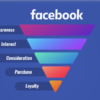Reviews
Feedback Genius Review: How the Pros Get More Amazon Reviews
Feedback Genius Review: If you want to be successful in selling your product on Amazon, then you that one of the major factors are getting more customer reviews. More reviews naturally build trust and influence buying decisions.
If you’re an established brand, then getting more reviews isn’t as difficult. You can count on your more loyal customers to leave you a review because they are likelier to love (or hate) your product.
But what if your brand or product is new? You’ll need a good strategy to consistently increase your customer reviews.
In the old days, you could use incentivized reviews. That is, you could give away hundreds of discounted products in exchange for reviews. There were tons of sites like Vipon and Snagshout that allowed you to do this.
This all changed on Oct 3, 2016, when Amazon finally decided to crack down on this practice.
So what is the best way to get more reviews on Amazon now? In my experience, it is by setting up an engaging email follow up sequence.
In this review, I’m going to take a look at a product that I personally use called Feedback Genius. It integrates with your Amazon seller account and helps automate the process of sending out these follow-up campaigns.
Why Email Follow Up Campaigns?
An email follow-up series is basically a drip campaign that you send to the buyers of your products over a period of time. The goal is to provide value (customer support, bonus guides) that will make your customer’s experience better.
By doing so, you increase your chances of getting a customer to leave a review.
Theoretically, you could send out a follow-up sequence manually through your Amazon account. But that quickly becomes unscalable if you are selling more than a handful of your product a day.
What about using your regular email service provider? Unfortunately, Amazon operates in its own closed ecosystem and as a seller, you don’t have direct access to your customer’s emails. So none of the various email service providers I’ve written about will work for this purpose.
This is why you need a service like Feedback Genius.
What is Feedback Genius
Feedback Genius is a cloud-based service from Seller Labs that allows you to set up an automated email series for each of your products. Each of the emails in your series will then get dripped out to each of your customers following a schedule you specify.
With Feedback Genius, I’ve created a 3 email sequence that’s been able to help me generate over 5000 reviews on my most popular product on Amazon. This one product averages 800-1000 sales a day.
How it works
The first thing you need to do after signing up to Feedback Genius is to hook it up to your Amazon seller account. This is straightforward and the site clearly walks you through the steps you need to take.
Once everything is setup, you next want to create an email series.
Feedback Genius provides an easy to use wizard for creating this.
The first page contains a simple to use email editor where you can write the content of your email. It has all the standard buttons for formatting your text. If you have a bonus attachment you can also do that from here.
Feedback Genius supports variables like [[buyer-name]] and [[product-review-link]] so you can personalize your emails and based on the customer and product they purchased.
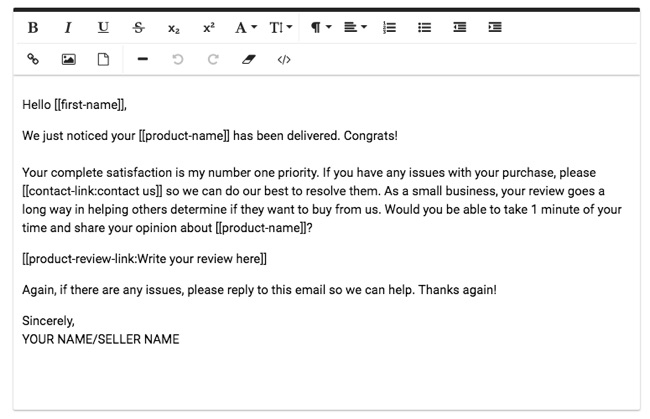
The 2nd page of the wizard lets you setup when and how your email will get sent out. Probably the most important setting is your delivery options. You have a choice to send your emails using one of these triggers combined with your own specified time period.
- Confirmed
- Shipped
- Marked ‘Out for Delivery’
- Delivered
- Positive Feedback Left
- Returned
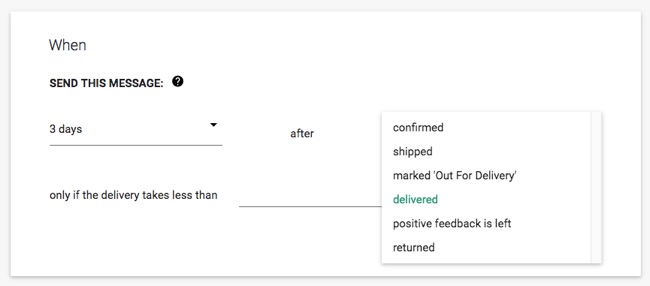
For example, you could create one email that is sent immediately after shipped, and another email that goes out 10 days after your product was delivered.
The other important option is to specify which ASIN or SKU you want your particular email to be attached to. You could have it be used on one or multiple products if you wanted.
Feedback Genius also includes more advanced filters to further target where your emails go.
Let’s say you are selling your product in both the US, France, and Germany. So instead of sending your English emails to everyone, including your French and German buyers, you can filter them so they only go to US buyers.
And if you decide to translate your emails into another language, you can make sure they are sent to the appropriate customers.
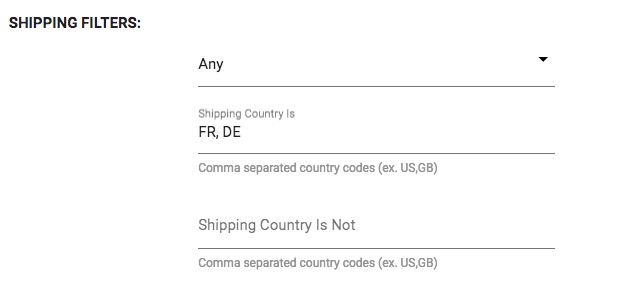
You also have the ability to skip sending messages to buyers who have left feedback already or if they have already returned your product.
And finally, you can customize your emails to your repeat buyers. This is super powerful since your most loyal members will be more likely to leave you a review.
How I’m Using Feedback Genius
I’ve been using Feedback Genius for a while, and I’ve found a pretty reliable formula for creating my email series and asking for reviews.
I’ll share my basic email framework below, but keep in mind that you should always aim to be original. Feedback Genius comes with some built-in templates and if you search online, you can certainly find people sharing their own templates as well.
But instead of copying them word for word, I recommend that you put your own spin on them and make them your own.
Customers receive these types of emails from sellers all the time, and they’ll tune yours out if it sounds the same as the rest of the emails they get in their inbox.
Email #1
Sent: Immediately after the product has shipped
Goal: Notify the customer that their product has shipped. A reminder of a key benefit they will get from my product once they receive it. Send them an extra value guide that I’ve prepared as a bonus for my customers.
Email #2
Trigger: 2-4 days after delivered
Goal: Ask the customer if their product came on time and if they received everything they are supposed to. Make sure that if they have any issues with the product, that they should email me directly to resolve it. Resend bonus guide in case they didn’t download it from the first email.
Email 3
Trigger: 7-10 days after delivered
Goal: Ask the customer if they have any issues with the product so far. Then go in and ask for a review.
Always keep testing your email series headlines and messages. A great headline will make a huge difference in your open rates over a poor one. So keep split testing various headlines until you find a good one.
Your email content also matters. With a poorly written email series, you might see less than a 1% increase in your Amazon review rate. But a clever, engaging email campaign might get you a 5-6% review rate. I’ve heard stories of people getting up to 10% in certain niches.
Other Benefits of Feedback Genius
Although I primarily use Feedback Genius for its ability to send out follow-up email sequences, it does include a couple other useful features.
Negative Seller Feedback Monitoring
Whenever you receive any negative seller feedback, you should always respond right away. Feedback Genius allows you to put in your cell phone number and email address and it will automatically notify you whenever a negative review gets posted. This lets you respond as soon as possible which demonstrates a level of customer service that can help build loyalty for your brand and products.
Message Analytics and Reports
Feedback Genius offers some basic analytics so you can see how your emails are performing. You can access them through the Messages tab and by choosing ‘Analytics’. There are 3 graphs that you can see.
One shows the number of sent emails versus opens over time. Another shows the message Opened/Unsubscribed % and message Clicked Rate % over time.
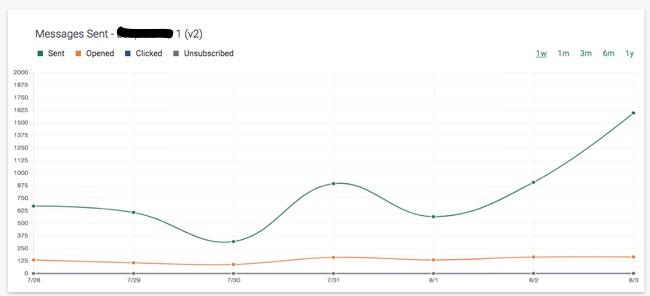
I’ve found the Clicked Rate % graph to be the most useful since it gives me some idea of how effective my call to action is.
Unfortunately, Amazon has made some changes that have affected Feedback Genius’ usage of tracking links. So currently it’s recommended to turn off click-through tracking and thus you won’t see any data for this particular graph.
Feedback Genius also offers 3 reports in the Reports tab. There’s the Feedback report which aggregates the overall monthly stats on your account and looks like this.

There’s also the Feedback Report which shows you how much seller feedback you get overtime.
And then the Recent Usage Report is mainly used to see how many of your monthly allotted emails you have left for the month.
What’s lacking is the ability to see the reviews I’m getting overtime for each product. That way I can see how changes to my email series are positively or negatively affecting the number of reviews I’m receiving.
One other criticism I have is that I’ve noticed that Feedback Genius is quite slow for larger accounts, especially when pulling up reports. It would be nice if they could make improvements in this area too.
Feedback Genius Pricing
Feedback Genius is a subscription-based service and it uses a pricing structure based on the number of emails you send out per month. For low volume Amazon sellers, you can send up to 100 emails for free by signing up to their Essentials plan. It’s a great way to test out how Feedback Genius can work for you.
Taking advantage of this plan, or just their 30-day free trial is a great way to test out how Feedback Genius can work for you.
Otherwise, you have your choice between the following plans:
- Startup – 1,000 emails – $20/mo
- Growth – 3,000 emails – $40/mo
- Premium – 10,000 emails – $80/mo
- Enterprise – 60,000 emails – $250/mo
So if you are selling 750 units a month, then figure that you will probably be in the Growth Plan (3 x 750 emails).
Final Thoughts
If you’re selling on Amazon, then it’s essential that you start sending out follow up email sequences to your customers. It’s the best way to improve the number of reviews you get, which will directly lead to more sales. I’m personally seeing a review rate of around 5%, which makes a huge difference when you are selling large volumes of product. That’s huge!
I’m personally seeing a review rate of around 5%, which makes a huge difference when you are selling large volumes of product.
I’ve been using Feedback Genius almost since I started selling on Amazon back in 2016 and it has worked very reliably for us. While there are certain things I’d like to see improved, the bottom line, it makes sending out follow up email sequences very easy.
If you’re just getting started, take their free trial and see if you can boost up your product’s Amazon reviews.
Feedback Genius Pros
- Free plan for low volume sellers.
- Can reliably send thousands of emails a day.
- Lots of advanced sending and filter options for emails.
Feedback Genius cons
- Reports are not particularly useful. Would like to see product-specific reports.
- Some performance issues when pulling up reports on large accounts.
- Customer support only on weekdays.
>>>Join The One Funnel Away Challenge<<<






















